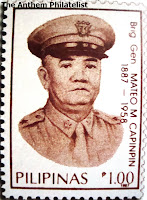Francisco Baltazar on Stamps

Francisco "Balagtas" Baltazar is known as the Prince of Tagalog Poets. A rival suitor for the favor of one Asuncion Rivera caused his imprisonment. It was during this confinement that he wrote his epic for which he is famous for, Florante at Laura.
Francisco Balagtas, later Francisco Baltazar or nickname Kikong Balagtas or Kiko, was born on April 2, 1788 in the barrio Panginay in the town of Bigaa, now known as Balagtas in his honor, in the province of Bulacan. He was the youngest of four children: Felipe, Concha, and Nicholasa. His parents where a blacksmith, Juan Baltazar, and Juana de la Cruz.
As a young boy, Balagtas loved to watch the land and hear the sound of the leaves. He saw beauty in the sparks caused by the pounding hammer of his blacksmith father. He even heard music in the sound of the horses' shoes.
Balagtas studied in a parochial school in Bigaa, where he studied prayers and catechism during his elementary years. Once Baltazar was eleven he moved to Tondo, Manila to work as a houseboy for his aunt, Doña Trinidad, who sponsored his studies. He enrolled at the Colegio de San Jose, where he graduated with degrees in Crown Law, Spanish, Latin, Physics, Christian Doctrine, Humanities, and Philosophy.
Dr. Mariano Pilapil taught him how to write while one of the most famous Tondo poets, José de la Cruz (Huseng Sisiw) mentored his poetry. Cruz challenged Balagtas to improve his writing, and even refused to edit Balagta's poetry. He continued to write more awits, corridos and moro-moros.
In 1835, Balagtas moved to Pandacan and met Maria Asuncion Rivera, who would later serve as a muse for his writings, such as in Florante at Laura as 'Celia' and 'Mar'.
Balagtas' feelings for Maria were challenged by Mariano Capule. The influential Capule used his wealth to imprison Balagtas and marry Maria. In prison, Balagtas relates the parallels of his own situation in Florante at Laura.
During an age when Filipino writings were written in Spanish, Balagtas wrote his poems in Tagalog. Scholars are lead to believe his poems reflect the abuses of the Spanish colonists.
Upon Balagtas' release from prison, he published Florante at Laura in 1838. In 1840, he moved to Udyong, Bataan and served as a Major Lieutenant. There, he met Juana Tiambeng of Orion, Bataan whom he would wed in 1842. Together, they had eleven - five boys and six girls - although seven died.
In 1849, Governor-General Narciso Claveria ordered that every Filipino native adopt a Spanish surname. Henceforth, Balagtas became known as Francisco Baltazar. He was imprisoned in 1856 for shaving the head of Alferez Lucas' housemaid, forcing his wife to spend their entire fortune to pay the court expenses. In 1860, he was released and continued writing to support his family.
Upon his death bed, Baltazar asked that none of his children become poets like him, who had suffered under his gift. He stated that it would be better to cut their hands off than to let them be writers.
Francisco Baltazar died on February 20, 1862.
Balagtas is considered the equivalent of William Shakespeare and the "Prince of Tagalog Poets" for his impact on Filipino literature with Florante at Laura regarded as his defining work. In fact, he is so greatly revered in the Philippines that a tradition held for debating in extemporaneous verse is known as 'Balagtasan'.
The stamp was issued on March 27, 1953.






